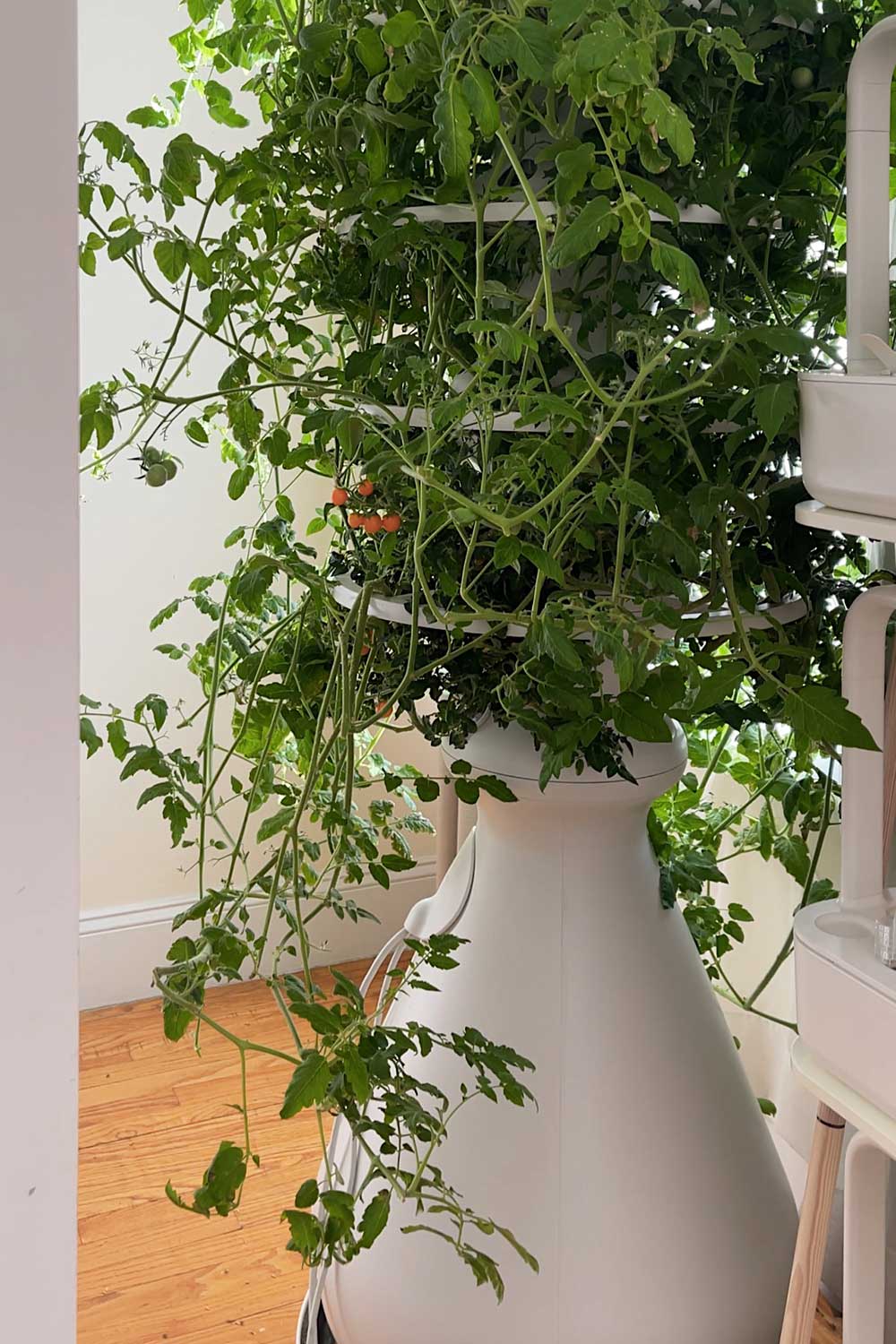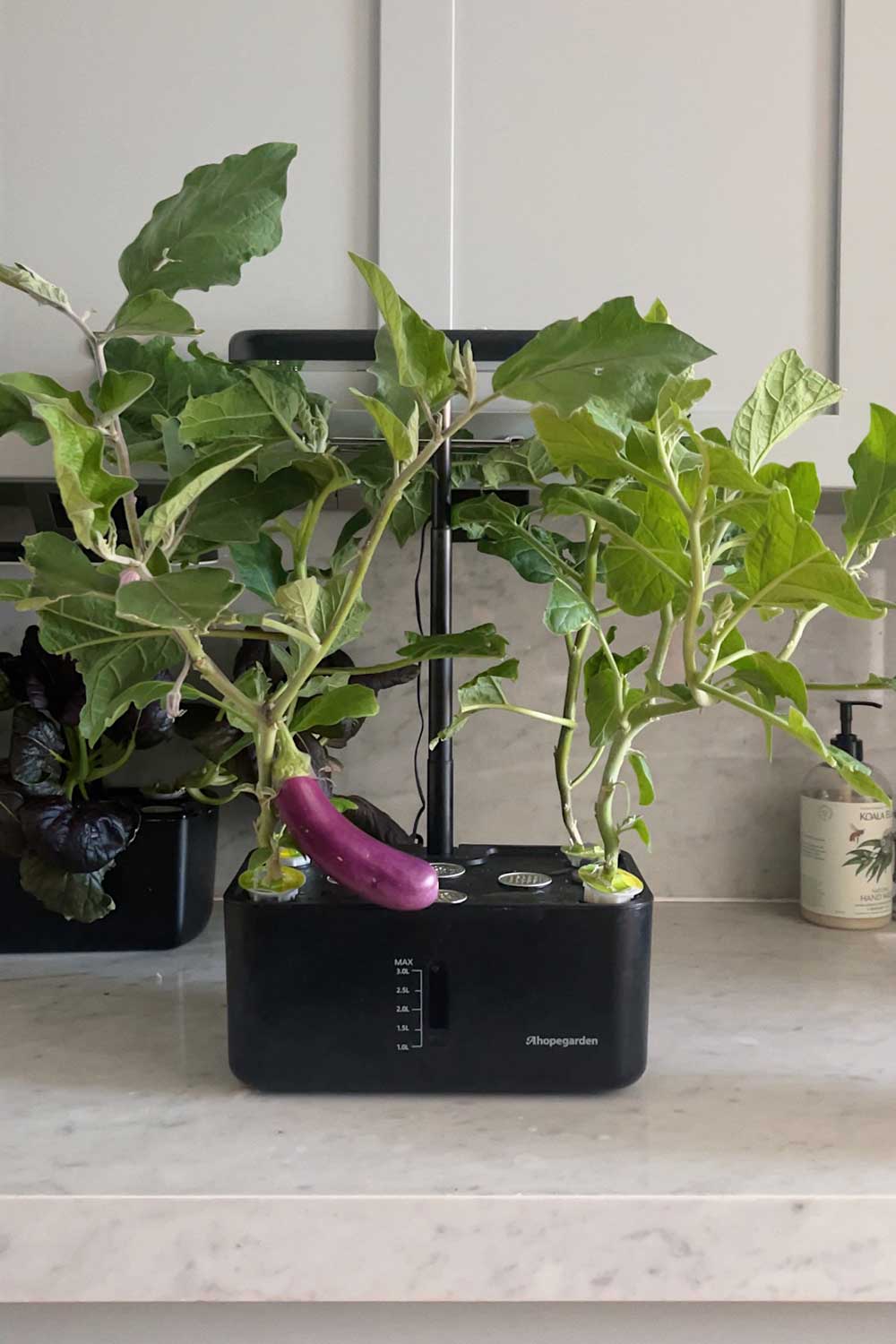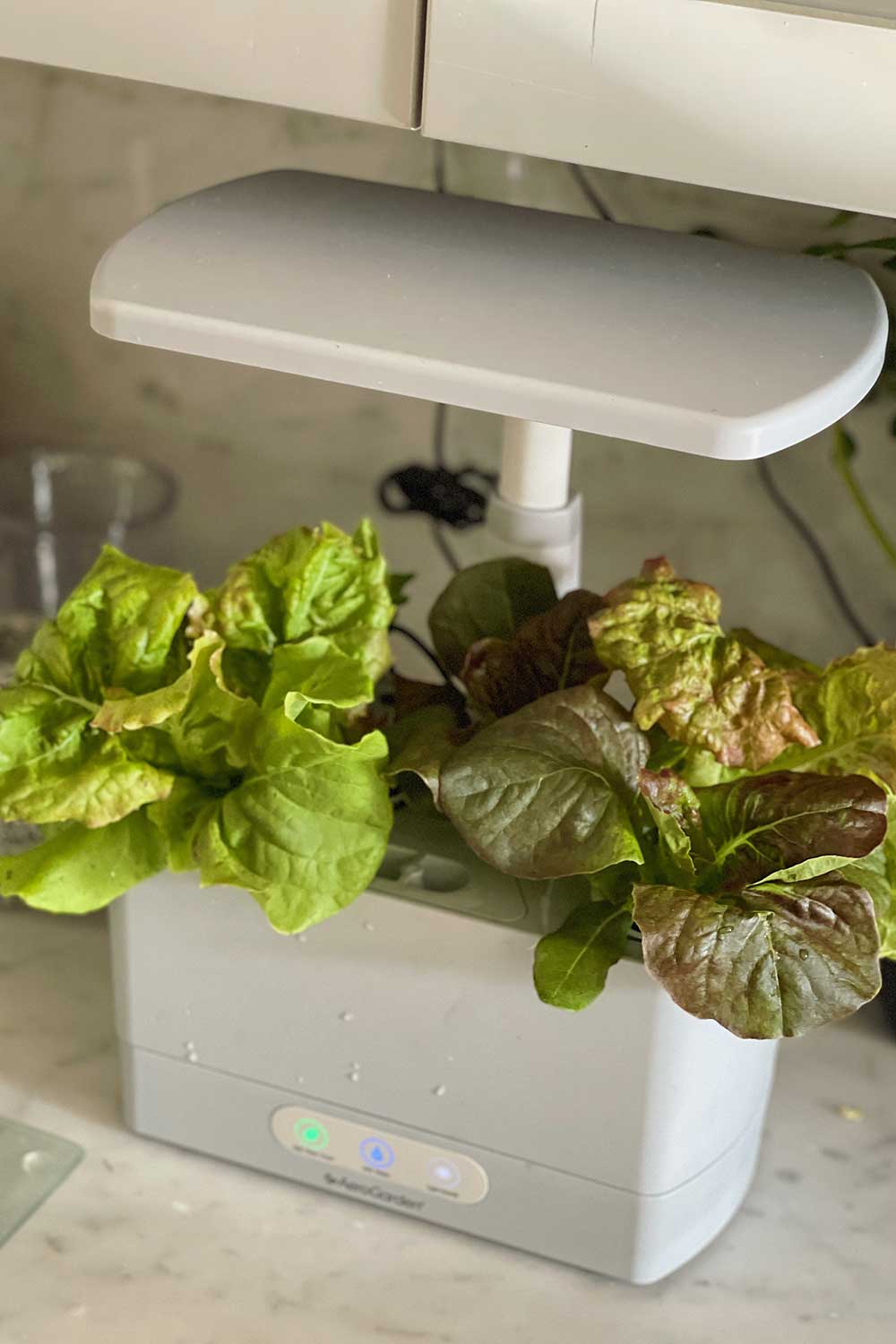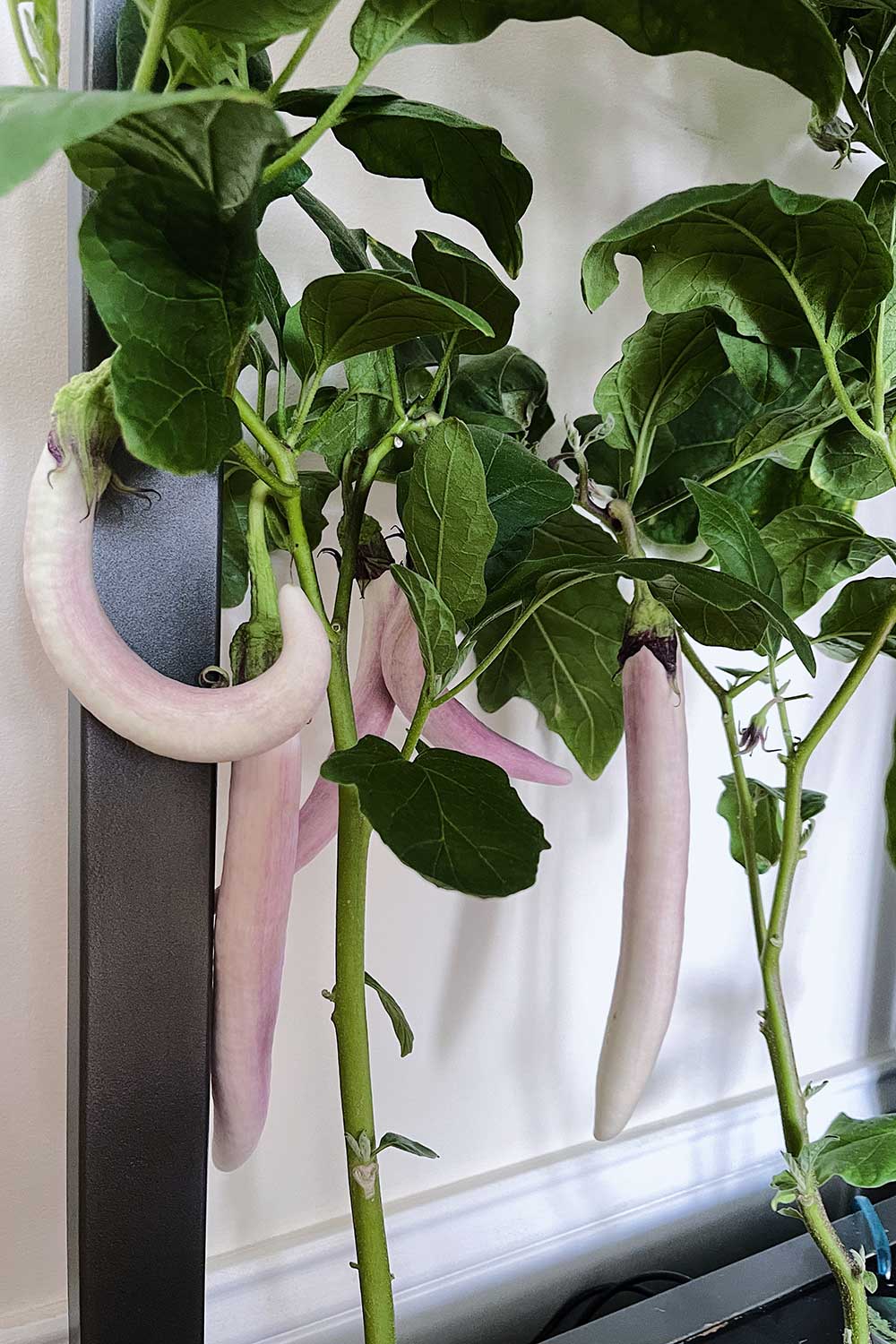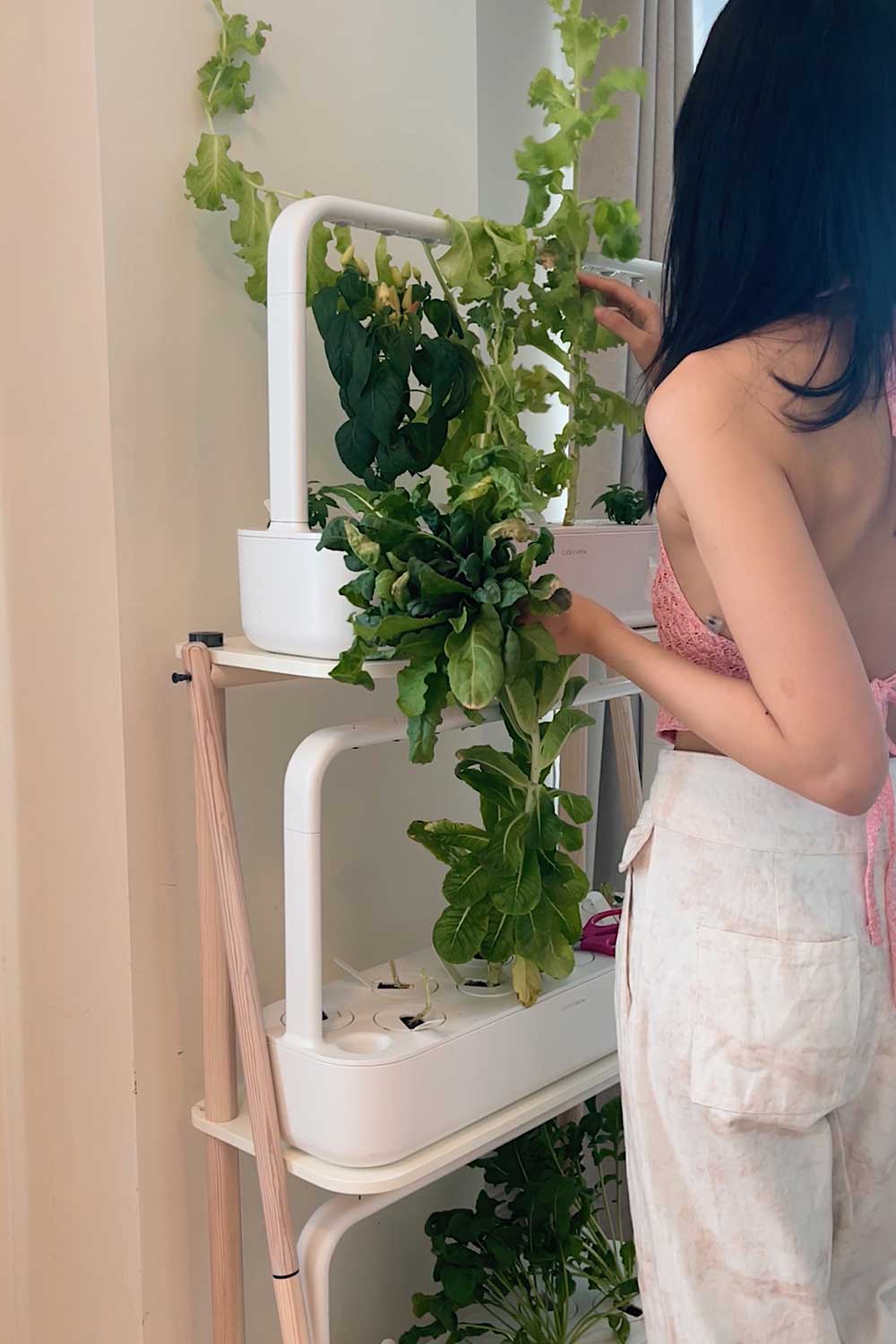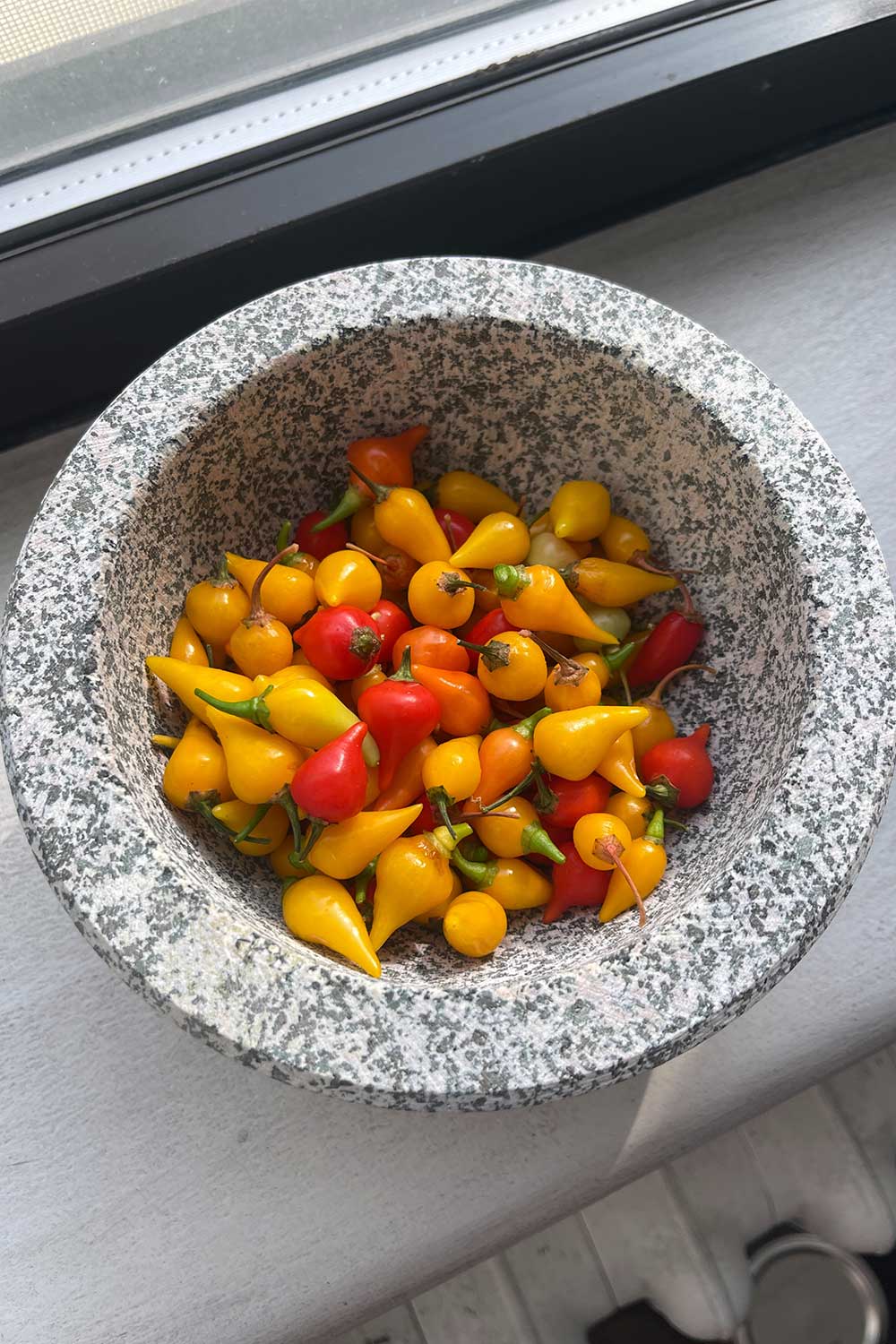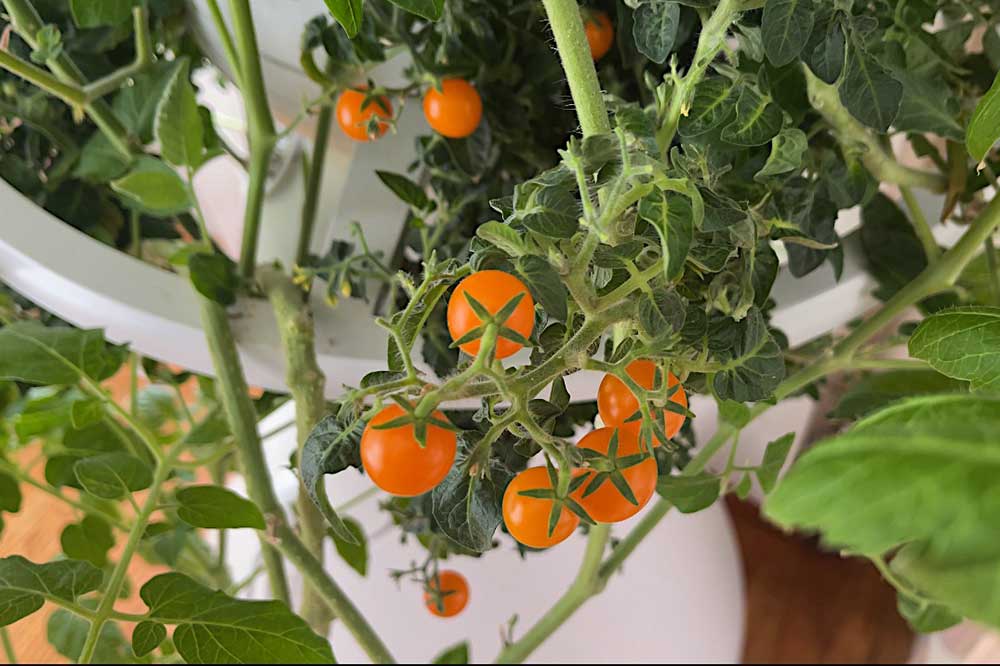
With indoor gardening, it’s important to understand the NPK ratio.
I use hydroponic machines to grow all my vegetables inside my apartment. These all-in-one systems take care of most of the gardening ‘work’ – watering, lighting, oxygenation.
But the one aspect you control is fertilization.
Just like people, plants need good nutrition to grow healthy and look their best.
Well-fed plants are also more productive and have better tasting vegetables.
If you’ve tried growing tomatoes in your indoor garden and been disappointed by the taste, it’s likely you didn’t dial in the nutrition quite right.
All fertilizer products will provide 3 important numbers so you can know the fertilizer’s N-P-K ratio and choose the best formula for your plants.
In today’s post, I’ll explain the significance of the letters N, P and K and give you a guide for how to read fertilizer labels to choose the best hydroponic nutrients for your indoor garden.
quickly jump to:
- What is NPK
- What fertilizer numbers mean
- How to apply NPK to your garden
- Understanding the NPK Ratio
- How NPK affects plants
- Which NPK ratio is best
- Soil vs hydroponic fertilizer
- Are hydroponic nutrients organic
- Nutrients for indoor gardening
- Do plants need different NPK fertilizers?
What Is NPK?
As I described in my plant nutrients post, there are 3 main macronutrients that plants need:
- nitrogen
- phosphorus
- potassium
These compounds are often abbreviated by their periodic table symbols N (for nitrogen), P (for phosphorus) and K (for potassium), hence the term N-P-K.
Because plants require larger quantities of nitrogen, phosphorous and potassium compared to other elements, they’re often depleted from the garden faster.
That’s why it’s important to supplement your garden and refresh them with additional N-P-K fertilizer.
Read more: Understanding Plant Nutrients
no matter what you’re growing, understanding nutrition is key to great tasting hydroponic vegetables
What Fertilizer Numbers Mean
Fertilizers are typically labeled with three numbers to indicate the relative content of the nitrogen, phosphorous and potassium.
For example, a 100 pound bag of 10-10-10 NPK fertilizer will have
- 10% nitrate
- 10% phosphate (which contains phosphorous)
- 10% potash (which contains potassium).
What the N, P and K numbers are telling you is the percentage of each macronutrient in the bag.
NPK values are always written in the same order, thus giving you an easy way to compare different formulations.
So, a 100 pound bag of 10-10-10 formula is the same as a 200 pound bag of 5-5-5 formula.
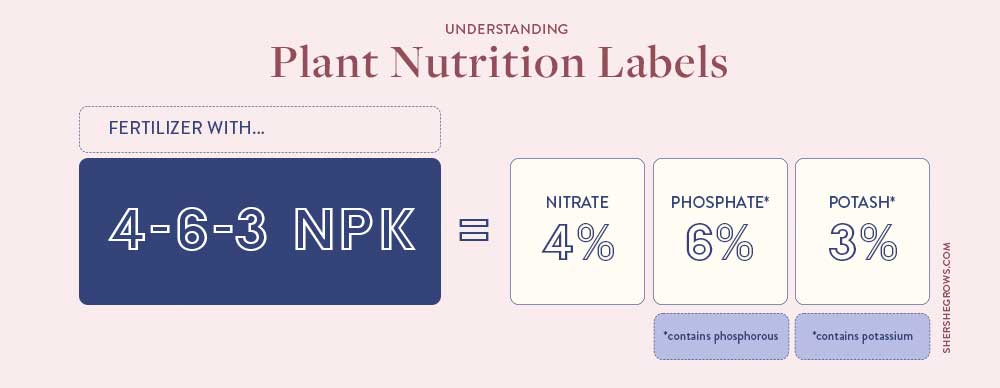
To be more precise, the first number (N value) is the percentage of elemental nitrogen by weight. Nitrogen is often delivered to plants in the form of nitrate, nitrite or urea.
The second number (P value) is the percentage by weight of phosphate, PO4. Phosphate is a common form of the element phosphorous.
The third number (K value) is the percentage by weight of potassium oxide, K2O (also known as potash). Potash is a common form of the element potassium.
Pure phosphorous is very reactive, so it’s not typically delivered in its pure element form.
Instead, phosphorous is typically to plants in the form of phosphate, a more stable form of phosphorous combined with oxygen.
Similarly, pure potassium isn’t something plants can use, so we provide them potassium salts in fertilizer through potash.
Note: this is for US fertilizer. Some other countries label their NPK fertilizer slightly differently, with the direct elements.
How to Apply N-P-K in Your Garden
NPK and fertilizer originated with traditional outdoor gardening, so I’ll explain it in that context first, then explain how it translates to hydroponic gardening.
People with outdoor gardens will often perform soil tests to understand what nutrients they need to supplement in their yard.
A soil test will analyze everything already existing in the soil, then suggest what concentrations you should add based on which nutrients are lacking.
So if a soil test comes back and says you should add 10 pounds of nitrogen, you’d look at your bag of fertilizer and know how much nitrogen is in the bag through the N-P-K numbers.
As an example:
If your soil test suggested your soil was deficient in phosphate and could benefit from 5 additional pounds and you had 2 brands of fertilizer to choose from, where:
- Bag 1 is a 100 pound bag of fertilizer with NPK 4-6-3
- Bag 2 is a 32 pound bag of fertilizer with NPK 6-4-0
Which would you choose?
Doing the math, you’d compare each by and find that:
Bag 1 contains
- 4 pounds of nitrate
- 6 pounds of phosphate
- 3 pounds of potash
- and 87 pounds of filler
Bag 2 contains
- 2 pounds of nitrate
- 1 pound of phosphate
- 0 potash
- and 29 pounds of filler
So you’d would go with bag 1, which has right about the level of phosphate your soil needs.
Note: organic fertilizers will typically have lower N-P-K ratios compared to synthetic fertilizers. In the US, fertilizers are only legally allowed to express readily available nutrients that plants can immediately use. Organic fertilizers are typically slow release where nutrients need to first decompose before they’re available to the plant.
Understanding the NPK Ratio
The numbers in the N-P-K label aren’t as important as the ratio of N to P to K.
What you really care about is the concentration of each macronutrient relative to the others.
10-10-10 fertilizer means it’s composed of 10% nitrate, 10% phosphate and 10% potash. Or, drilled down, they’re in a 1-1-1 ratio where each macronutrient is provided in equal proportions.
Meanwhile, a 20-5-5 fertilizer means it’s composed of 20% nitrogen, 5% phosphate and 5% potash. This fertilizer has 4x more nitrogen than phosphorous and potassium and is heavy on nitrogen.
For beginner gardeners there’s no need to overcomplicate it with math, just quickly get an idea of the ‘main’ macronutrient by at the NPK ratio.
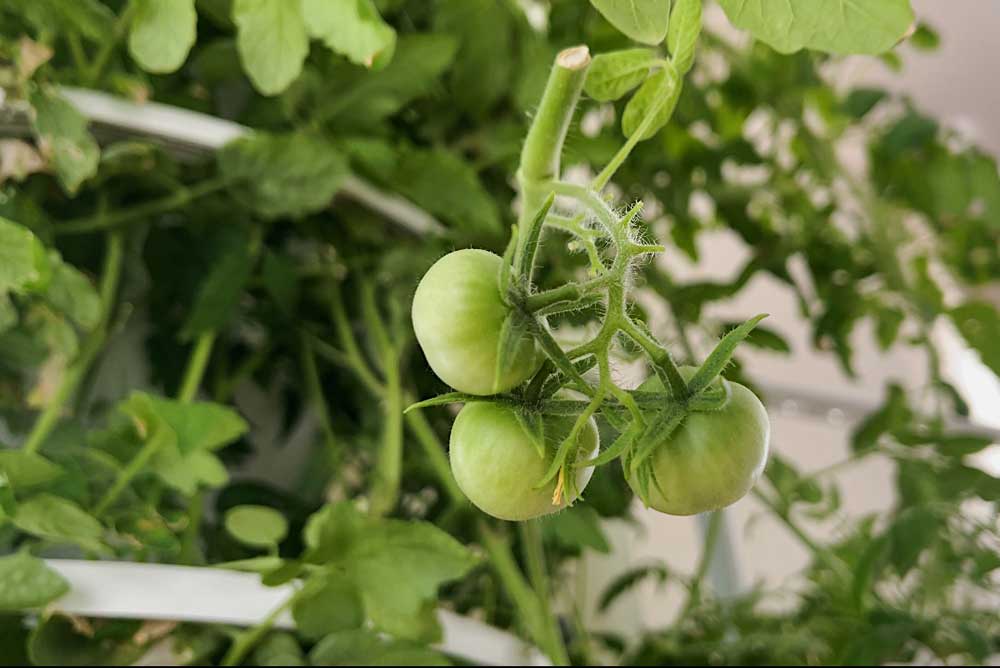
How NPK Affects Plants
I explained the significance of each nutrient in plant fertilizer in this post.
But at a high level, each of the three nutrients in the N-P-K provide the plant with different things:
Nitrogen is needed for vigorous, leafy growth.
It’s responsible for the rich green color in leaves and without it, plants will turn pale or yellow and be slow down to grow.
Too much nitrogen in a flower or fruit bearing plant will tell the it to focus its energy on green growth, and you’ll end up with fewer blooms and fruit.
Phosphorous promotes strong root development, important for plants to strengthen and anchor themselves.
Phosphorous also increases flower, fruit and seed formation.
Too little phosphorous will lead to flower and fruit deficiencies, while extra phosphorous will boost blooms and fruits.
Potassium enhances overall growth by helping plants fight off disease and weather temperature differences.
It regulates both top growth and underground root growth and keeps plants overall healthy, balanced and vigorous.
Plants with potassium deficiencies will be extra sensitive to drought and may display stunted leaves or fruits.
Most soils contain enough potassium, so typically this third number in fertilizer formula is the smallest.
When to Use Different NPK Ratios
Grassy areas need lots of nitrogen for rich green color and vigorous growth.
Lawn fertilizer will typically have a high first number in their NPK ratio. For example, a 22-23-4.
Vegetables like tomatoes and peppers need nitrogen as well, but higher concentrations of phosphorous.
Most tomato or fruit-bearing vegetable fertilizers will have a higher P value. For example, a 4-5-4.
Flowers need more phosphorous as well, but a little less potassium to produce their blooms.
So flower specific fertilizers will often have an NPK ratio with the highest P value, high N values and lower K values. Something like a 4-6-3.
A balanced fertilizer typically has an even N P and K, like a 10-10-10 or 4-4-4.
These all-in-one fertilizers are designed to be used on all types of plants, from indoor houseplants to vegetable gardens and flower beds.
Are Fertilizers the Same for Soil and Hydroponic Gardening?
No. It’s important to use a hydroponic nutrient formula for your indoor gardens.
Soil contains a lot of nutrients for plants that they don’t get from hydroponic environments. So fertilizer for traditional soil gardening will contain a different composition of elements.
With plants grown in water, they need a more complete nutrient formula and they need water soluble plant food.
For example, nitrogen can be delivered in several forms.
In organic soil fertilizer, it’s often delivered in urea (essentially, urine waste from animals). Urea is not soluble in water and takes a long time to break down.
So if you were to add a urea-based fertilizer to a hydroponic garden, the plants would die before being able to access the nutrients.
Instead, hydroponic formulas usually have nitrate to deliver nitrogen to plants.

hydroponic peppers can often be hotter than those grown outdoors
Hydroponic Nutrients vs Soil Nutrients
Soil, even low quality, poor soil, will contain some set of nutrients.
When you’re gardening outdoors in soil, it’s important to first run a soil test to see which nutrients are missing from your soil.
Then, you’d add a fertilizer with the NPK ratio to add back the specific macronutrients that are deficient.
But hydroponic gardening uses no soil. Plants are grown entirely in water, with soil-less substrates to hold the plants in place.
Growing mediums like potting mix, sponges, coco coir and clay pebbles don’t contain any of the nutrients that soil has, so your plants are entirely reliant on you for food.
I personally think that makes indoor gardening much easier than traditional gardening.
You can give your plants a simple, all in one fertilizer (look for one with an NPK ratio roughly around 3:1:2) and they’ll thrive.
No need for soil tests, math calculations or plant specific fertilizers, any hydroponic nutrient with equal parts N, P and K will work just fine.
Are Hydroponic Nutrients Organic?
Sometimes people ask me if hydroponic nutrients are organic.
And I get why, especially if they have experience with traditional gardening outside.
With soil amendments, people do tend to prefer organic fertilizers. They take longer to break down, but are considered more natural than synthetic chemicals.
With hydroponics, organic formula isn’t really available.
Lots of organic formulas aren’t water soluble.
The options that are tend to stink. A common source of nitrogen is fish pee, which most people wouldn’t want to smell in their home.
And in general, organic fertilizer is very slow to break down, much too slow for how quickly hydroponic plants grow.
Don’t worry though – hydroponic nutrients, although not ‘organic’, are typically made of minerals and salts, so they’re not the same as synthetic soil fertilizers.
Nutrients for Indoor Gardening
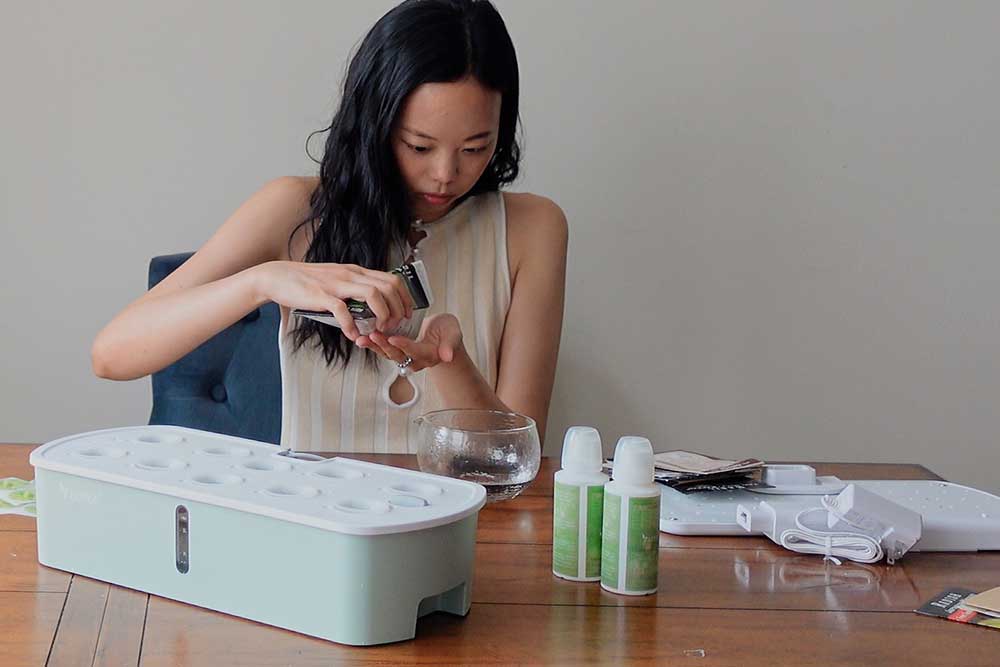
When you buy an indoor garden for the first time, almost every brand will include nutrients to get you started.
I recommend this countertop garden if you’re a beginner. It’s beautifully designed, well-constructed and can fit 10 plants in a small space.
It’s also incredibly affordable, making it great for first timers looking to get started with indoor gardening. Use code INFLUEN10 to save an extra 10% off.
Inexpensive Amazon indoor gardens typically provide nutrients in the form of A and B bottles.
These are a two-part dry nutrient solution, where add water to dissolve the minerals.
Then, every 2 weeks, you pour in a couple capfuls of the now-liquified hydroponic solution. Just follow the package directions.
I don’t love A and B nutrients personally.
Instead, I’d recommend using Aerogarden’s liquid plant food. I have a in-depth guide to it here, but essentially it’s a ph buffered, all-in-one liquid hydroponic nutrient.
Water quality plays a large role in nutrient availability and overall plant health. I use tap water here in New York City, which is known for its excellent water quality.
Depending on the mineral content, alkalinity and pH of your water, you may need to filter your tap or use distilled.
In any case, using a ph-buffered nutrient like Aerogarden’s liquid nutrients can make a difference!
As you get more experienced, you can try out different nutrients. I have a guide here to all the brands I’ve tried here, and their pros and cons.
Read more: A Quick Guide to All the Hydroponic Nutrient Brand I’ve Tried
Which nutrient formula is best?
Plants go through different stages in their growth cycle:

In their vegetative and growth stage, plants require higher levels of nitrogen, so you’ll want a hydroponic nutrient formula with a higher ratio of N relative to the other macronutrients.
In their flowering stage, plants will require higher levels of phosphorous, so you’ll want a formula with a higher ratio of K.
I recommend choosing a great ‘all in one’ fertilizer, especially if you’re a beginner indoor gardener.
If your plants show signs of nutrient deficiencies, then you can bump up and supplement.
For beginners to indoor gardening, I’d recommend any of these:
Whichever brand you choose, make sure to follow the directions on the back of the bottle. They’ll guide you to adding the right concentration for your size of indoor garden.
Note: your nutrient dosage depends on the water capacity of your garden reservoir, not the number of plants.
Whether you’re planting one vegetable in a 1 liter indoor garden or 6 vegetables in a 1 liter garden, you’ll want to use the same nutrient dosage.
while you can get buy with using the same hydroponic fertilizer for all your plants, tweaking the nutrition slightly based on plant type will get even better results
Do Different Plants Need Different Nutrient Formulas?
If you’re growing leafy greens like lettuce, bok choy or chard, you can stick with the same all-purpose base nutrient for the plant’s entire life cycle.
If you’re growing larger fruiting plants like tomatoes, eggplants or peppers, you can start with the all-purpose vegetative nutrient.
When they’ve reached the flowering stage, then switch or supplement with the flowering formula.
I use this bloom nutrient for my heavy vegetable feeders.
Whether you add or swap formula depends on the brand.
Some brands make ‘complete’ formulas where the flowering formula replaces the vegetative.
Others make ‘part’ formulas, where you’d add more fruiting formula to adjust the N P K ratio depending on the growth mode. This is an example of a 3 part hydroponic nutrient.
So just refer to the package directions.
Hope this helps! Today’s post was focused on explaining the basics of plant fertilizers.
In my next post, I’ll talk more about intermediate nutrient tips!
Follow me on
Youtube | Tiktok | Instagram | Substack
